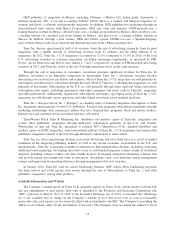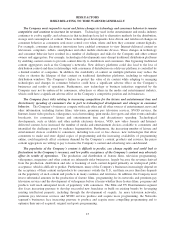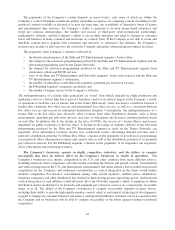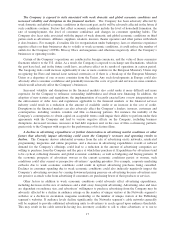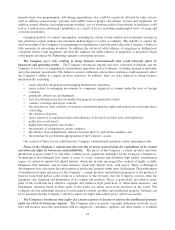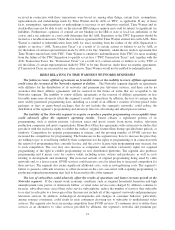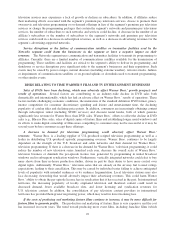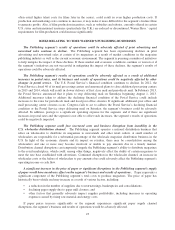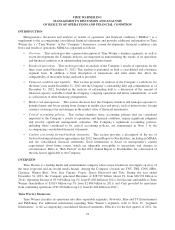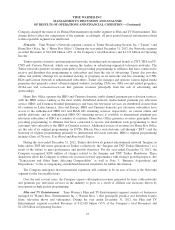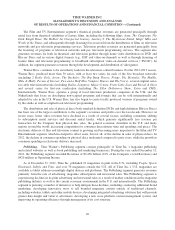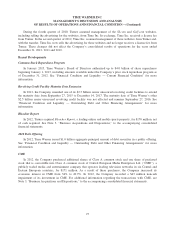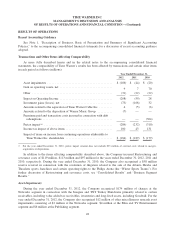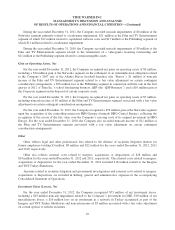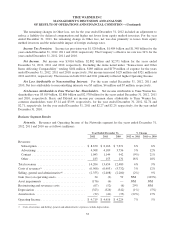Time Magazine 2012 Annual Report Download - page 39
Download and view the complete annual report
Please find page 39 of the 2012 Time Magazine annual report below. You can navigate through the pages in the report by either clicking on the pages listed below, or by using the keyword search tool below to find specific information within the annual report.often entail higher talent costs for films later in the series), could result in even higher production costs. If
production and marketing costs continue to increase, it may make it more difficult for the segment’s feature films
to generate profits. Also, if film production incentives, such as subsidies and rebates, currently offered in certain
U.S. states and international territories (particularly the U.K.) are reduced or discontinued, Warner Bros.’ capital
requirements for film production could increase significantly.
RISKS RELATING TO TIME WARNER’S PUBLISHING BUSINESSES
The Publishing segment’s results of operations could be adversely affected if print advertising and
newsstand sales continue to decline. The Publishing segment has been experiencing declines in print
advertising and newsstand sales at certain of its magazines as a result of market conditions in the magazine
publishing industry as well as the current economic environment. The segment is pursuing a number of initiatives
to help mitigate the impact of these declines. If these market and economic conditions continue or worsen or if
the segment’s initiatives are not successful in mitigating the impact of these declines, the segment’s results of
operations could be adversely affected.
The Publishing segment’s results of operations could be adversely affected as a result of additional
increases in postal rates, and its business and results of operations could be negatively affected by other
changes in postal service. The U.S. Postal Service’s financial condition continues to decline. In 2012, the
Postal Service closed 46 of its mail processing centers and announced plans to close additional processing centers
in 2013 and 2014, which will result in slower delivery of first class mail and periodicals mail. In February 2013,
the Postal Service announced that it plans to stop delivering mail on Saturdays beginning August 1, 2013.
Additional measures taken to address the declining financial condition of the Postal Service could include
increases to the rates for periodicals mail and local post office closures. If significant additional post office and
mail processing center closures occur, Congress fails to act to address the Postal Service’s declining financial
condition or the Postal Service stops delivering mail on Saturday, the segment’s business could be adversely
affected. In addition, postage is a significant operating expense for the segment, and if there are significant
increases in postal rates and the segment is not able to offset such increases, the segment’s results of operations
could be negatively impacted.
The Publishing segment could face increased costs and business disruption from instability in the
U.S. wholesaler distribution channel. The Publishing segment operates a national distribution business that
relies on wholesalers to distribute its magazines to newsstands and other retail outlets. A small number of
wholesalers are responsible for a substantial percentage of the wholesale magazine distribution business in the
U.S. In light of the economic climate and its impact on retailers, there may be consolidation among the
wholesalers and one or more may become insolvent or unable to pay amounts due in a timely manner.
Distribution channel disruptions can temporarily impede the Publishing segment’s ability to distribute magazines
to the retail marketplace, which could, among other things, negatively affect the ability of certain magazines to
meet the rate base established with advertisers. Continued disruption in the wholesaler channel, an increase in
wholesaler costs or the failure of wholesalers to pay amounts due could adversely affect the Publishing segment’s
operating income or cash flow.
A significant increase in the price of paper or significant disruptions in the Publishing segment’s supply
of paper would have an adverse effect on the segment’s business and results of operations.Paper represents a
significant component of the Publishing segment’s total costs to produce magazines. The price of paper has
historically been volatile and may increase as a result of various factors, including:
• a reduction in the number of suppliers due to restructurings, bankruptcies and consolidations;
• declining paper supply due to paper mill closures; and
• other factors that generally adversely impact supplier profitability, including increases in operating
expenses caused by rising raw material and energy costs.
If paper prices increase significantly or the segment experiences significant paper supply channel
disruptions, the segment’s business and results of operations would be adversely affected.
23


